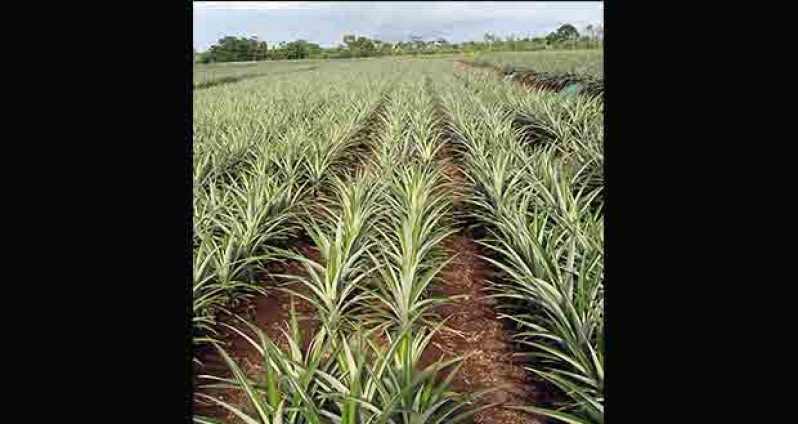
In Guyana, the main pineapple producing areas are located in Pomeroon- Supenaam; Essequibo Islands-West Demerara and Demerara Mahaica. Between 2013 and 2015 local farmers produced approximately 72,791 metric tons (MT) of pineapples. Montserrat is the main variety grown. Other varieties cultivated in small quantities are Sugar Loaf, Smooth Cayenne, and Tiger Head.
Pineapples grow well on a wide range of soils. Some pineapples are grown on the upland sandy soils, but most of the commercially grown pineapples are on riverine silt loams, clay loams and clay high in organic matter that have benefitted from improved drainage and water control systems. Best growth is achieved on well-drained, fertile, sandy loam soils with a pH range of 4.5-5.5.
But, even with its firm exterior, crown and hard leaves, pineapples, like other crops, are susceptible to pest and diseases. One such disease is the scarlet tip. Evidence supports that the presence of a virus causes pineapple plants to be infected with the “scarlet tip” disease.
There are two pests that are likely to transmit this virus. It is believed that the pineapple mealybug (Dysmicoccus brevipes) whilst feeding diffuses the virus via saliva onto the plant. And, nematodes, (microscopic worms) have also been reported to be involved in the development of the condition, but this is yet to be confirmed.
The Montserrat variety is most susceptible to this condition in Guyana. The symptoms can be described in four stages. During the first two stages the leaves discolour transitioning from green to pink and then to red or bronze. The tip of the leave changes from pink to yellow and the leaf curls downwards. The plant begins to wilt. The leaves, and essentially the entire plant, go through a horrifying process of withering during the third and fourth stages. Fruits produced from infected plants are usually reduced in size, malformed with fibrous, corky and sour flesh.
Detecting the “scarlet tip” disease in the early stage may be difficult. Even after plants have been infected with the virus the scarlet symptom may take a period before visibility. The timespan varies depending upon a number of factors including the nutrient status of the plant; the number of mealybugs feeding on the plant; frequency of feeding of mealybugs on the plant; plant age; and prevailing weather conditions.
However, plants of any age have been observed to be affected by “scarlet tip,” but those that have reached 12 to 15 months seem to succumb to the condition more readily than younger or older plants.
Unfortunately, Guyana’s weather conditions seem favourable for the development of “scarlet tip”. During hot or sunny conditions the disease symptoms appear most enhanced. With the onset of rains and cooler conditions, some plants may recover from the symptoms.
As a control measure the farmer needs to burn all disease stricken plants as soon as they are spotted in the field. Further, the careful selection of planting materials is required. For instance: Mother plants, from which materials are selected should be green in colour; free from rots and gums; and definitely free from mealybugs.
It is important that planting materials selected should be treated to promote healthy plant growth. The treatment process includes the trimming of old dry tissues that will form roots; and apply a solution of Basudin 0.05% or Malathion 0.1% before planting. The planting material should remain in the solution for about 20 minutes. Following which the planting material should be inverted and allowed to drain. Planting can begin the following day.



.jpg)









